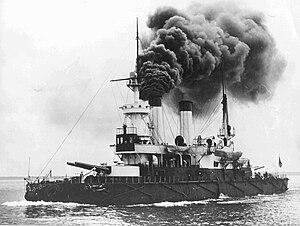Admiral Ushakov-class coastal defense ship
 Admiral Seniavin underway in 1901
| |
| Class overview | |
|---|---|
| Builders | New Admiralty Shipyards and Baltic Works, Saint Petersburg, Russia |
| Operators | list error: <br /> list (help) |
| Built | 1892–1899 |
| In commission | 1895–1935 |
| Planned | 3 |
| Completed | 3 |
| Lost | 1 |
| Scrapped | 2 |
| General characteristics | |
| Type | coastal defense ship |
| Displacement | 4,971 long tons (5,051 t) |
| Length | 87.3 m (286 ft 5 in) |
| Beam | 15.85 m (52 ft 0 in) |
| Draught | 5.9 m (19 ft 4 in) |
| Propulsion | list error: <br /> list (help) 2 shaft vertical triple expansion steam engines 4-8 cylindrical coal-fired boilers 5,750 ihp (4,290 kW) 450 tons coal |
| Speed | 16 knots (18 mph; 30 km/h) |
| Complement | 404 |
| Armament | list error: <br /> list (help) 3 or 4 - 10 in (254 mm) guns 4 × 1 - 4.7 in (120 mm) guns 6 × 1 - 47 mm (2 in) 3-pounder guns 10 × 1 - 37 mm (1.5 in) 1-pounder guns 4 × 15 in (381 mm) above water torpedo tubes |
| Armour | list error: <br /> list (help) Harvey armour Belt: 4–10 in (102–254 mm) Decks: 2–3 in (51–76 mm) Turrets: 8 in (203 mm) Conning tower: 8 in (203 mm) |
The Admiral Ushakov-class were coast defense battleships built for the Imperial Russian Navy during the 1890s to counter armored ships of the Swedish Navy. All three ships were stationed in the Baltic Sea when the Russo-Japanese war began and sailed with the Baltic Fleet around the Cape of Good Hope to the Pacific. Two ships were captured by the Japanese and one was scuttled during the Battle of Tsushima.
Design
General characteristics
They had an overall length of 286 ft 6 in (87.33 m), a beam of 52 ft (16 m), and a draft of 19 ft 6 in (5.9 m) at deep load. They displaced 4,971 long tons (5,051 t).[1]
Propulsion
The Admiral Ushakovs used vertical triple expansion steam engines that produced 5,750 ihp (4,290 kW). They were fed by 8 cylindrical coal-fired boilers, except in Admiral Ushakov which only had four boilers. The engines drove 2 shafts for a maximum speed of 16 knots (18 mph; 30 km/h). They carried 300 long tons (300 t) of coal at normal load and 450 long tons (460 t) at deep load.[1]
Armament
The Admiral Ushakovs had four 45-caliber 10-inch (254.0 mm) guns in two twin-gun turrets, mounted fore and after of the superstructure, except for General Admiral Graf Apraksin, whose rear turret only had a single gun. Their secondary armament consisted of four 4.7 in (120 mm) guns mounted in casemates at the corners of the superstructure.[1]
Armor
Their armor consisted of a 10-inch (254 mm) waterline belt 170 feet (52 m) long that protected the ship's vitals. It tapered down to 4 inches (102 mm) at the ends where it met bulkheads 6–8 inches (152–203 mm) thick that protected the ends of the ship. The deck was 2–3 in (51–76 mm) thick. The turrets and the conning tower had 8 inches (203 mm) of armor. Harvey armour was used throughout.[1]
Construction
| Ship | Builder | Laid down | Launched | Commissioned |
|---|---|---|---|---|
| Admiral Ushakov | New Admiralty Shipyards | 1 January 1892 | 1 November 1893 | February 1895 |
| Admiral Seniavin | Baltic Works | August 1892 | 22 August 1894 | 1896 |
| General Admiral Graf Apraksin | New Admiralty Shipyards | 24 October 1894 | 12 May 1896 | 1899 |
In service
Russo-Japanese War
The three Admiral Ushakovs were assigned to the 3rd Pacific Squadron, under the command of Rear-Admiral Nikolai Nebogatov, and sailed on 2 February 1905 to reinforce Admiral Zinovy Rozhestvensky's 2nd Pacific Squadron enroute to the Pacific. They left the Baltic Sea and sailed around Europe, through the length of the Mediterranean Sea, through the Suez Canal, across the Indian Ocean, into the South China Sea where they rendezvoused at Van Fong in French Indochina on 26 April. They departed the anchorage on 1 May and encountered the Japanese fleet on 14 May at what would be called the Battle of Tsushima.[2]
For most of the first part of the battle Nebogatov's ships trailed the more powerful 2nd Squadron and were largely ignored by the Japanese so his ships were in good shape when night fell. Admiral Siniavin had not been hit at all, although Admiral Ushakov had had her bow smashed. He had ordered his ships to turn north to make for Vladivostok earlier in the day, after Admiral Rozhestvensky had been wounded, but he ordered a turn to the southwest to evade Japanese torpedo boats during the evening, but turned north during the night. Admiral Ushakov could not make the required speed to keep up and fell out. She was either sunk or scuttled by her crew during the following morning. Admiral Seniavin and General Admiral Graf Apraksin remained with him and surrendered the following morning when he was spotted by the Japanese fleet.[3]
Notes
Bibliography
- Gardiner, Robert, ed. (1979). Conway's All the World's Fighting Ships 1860—1905. New York: Mayflower Books. ISBN 0-8317-0302-4.
- Gribovskii, V. Y. (1996). Battleship Admiral Ushakov (in Russian). Saint Petersburg, Russia: Zamechatelʹnye korabli. ISBN 5-7355-0356-1. OCLC 36969945.
{{cite book}}: Unknown parameter|coauthors=ignored (|author=suggested) (help) - Pleshakov, Constantine (2002). The Tsar's Last Armada. New York: Basic Books. ISBN 0-465-05791-8.